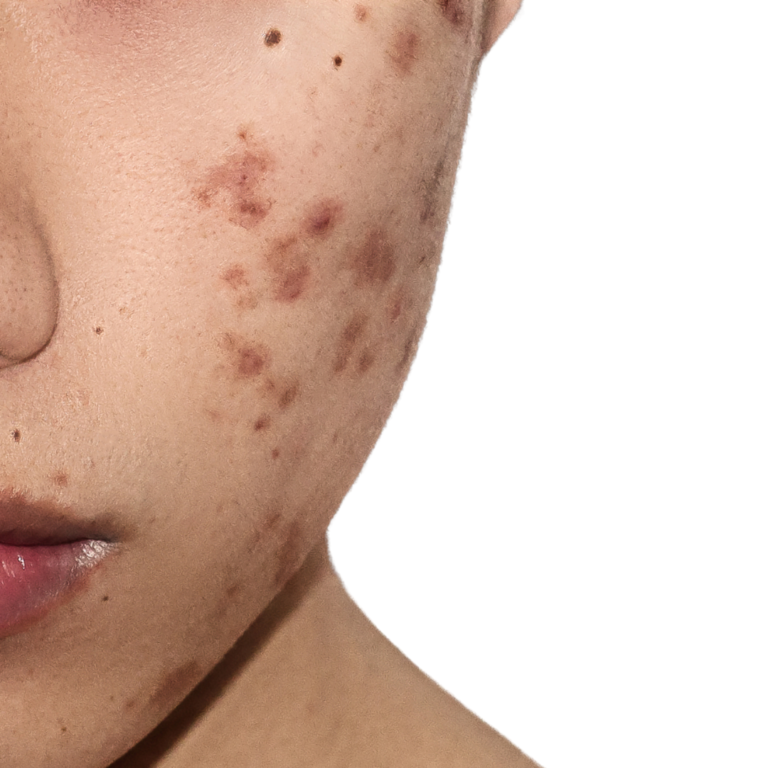What causes acne scars?
Acne scars usually appear because of the body’s attempt to heal itself after severe acne lesions have destroyed the skin’s dermis, the deepest layer below the surface. This damage triggers the body’s natural repair process, which can lead to scarring. Factors that contribute to scarring include:
- Inflammation: Inflammatory acne, such as cysts or nodules, can damage the surrounding skin tissue, leading to scarring.
- Genetics: A person’s genetic makeup can affect how the skin responds to acne and the likelihood of scarring.
- Delayed or inadequate treatment: Not treating acne early or using harsh treatment methods can increase the risk of scarring.
- Picking or popping pimples: Picking on acne lesions can worsen inflammation and damage the skin, promoting scar formation.
- Identifying Acne Scars: Types and Appearance
Acne scars can manifest in various forms and each type has distinct characteristics:
- Atrophic scars: Appear as small indentations or depressions in the skin, often referred to as “ice pick”, “box” or “roller” scars.
- Hypertrophic or keloid scars: Raised, firm scars that form when the body produces excess collagen during the healing process.
- Post-inflammatory hyperpigmentation (PIH): Dark spots or discoloration left behind after acne lesions heal.
- Management and treatment options
While complete prevention of acne scars may not always be possible, several treatments can help minimize their appearance:
- Procedures: Dermabrasion, microneedling, chemical peels, laser therapy, and dermal fillers are options offered by dermatologists to reduce scarring.
- Professional skin care: Dermatologist-recommended skin care routines can target specific types of scars and help fade them.
Lifeline® Skin Care ProPlus Acne Scar Collection
Acne scars can be a persistent reminder of past skin struggles, affecting confidence and self-esteem. However, we offer a custom collection designed to effectively address these concerns and is precision-crafted, incorporating powerful ingredients known for their ability to rejuvenate and repair damaged skin. Each product in this collection serves a distinct purpose in fighting acne scars, offering a complete treatment for clearer, smoother skin.
Dual Action Exfoliator: This plays a vital role in this scheme. Its blend of exfoliating agents, including glycolic acid, gently removes dead skin cells and encourages cell renewal. This procedure can help fade acne scars by reducing the appearance of uneven texture and discoloration.
Brightening Cleanser and Brightening Toner: This duo works in harmony to cleanse and prepare the skin for optimal absorption of subsequent treatments. Enriched with antioxidants like green tea and licorice root, these products aim to brighten skin and may reduce the appearance of dark spots and pigmentation left behind by acne scars.
ProPlus Advanced Water Therapy: At the heart of Lifeline Skin Care’s acne scar collection is Advanced Aqueous Treatment ProPlus. Enriched with powerful ingredients such as peptides, growth factors and hyaluronic acid, this treatment aims to stimulate collagen production and enhance skin elasticity. Peptides aid in cell repair, while growth factors promote skin regeneration, critical to minimizing the appearance of acne scars.
The science behind the ingredients
The effectiveness of Lifeline® Skin Care ProPlus products lies in the carefully selected ingredients known for their rejuvenating properties:
Peptides and growth factors: These elements stimulate collagen production, helping to repair and regenerate the skin, thus reducing the appearance of scars.
Glycolic Acid: An alpha hydroxy acid (AHA) that exfoliates the skin, promoting the shedding of dead skin cells and encouraging a smoother skin texture.
Hyaluronic Acid: Known for its ability to retain moisture, providing hydration and firmness to the skin, improving overall texture.
Antioxidants: These ingredients work synergistically to brighten skin and reduce pigmentation caused by acne scars.
It is important to consult with a dermatologist or skin care professional to determine the most appropriate treatment plan based on individual skin type, scar severity, and desired results.
Empowering yourself
Remember, managing acne scars is a journey that requires patience and consistency. While treatments can significantly reduce the appearance of scars, it may take time to see noticeable improvements. In addition, practicing good skin care habits, protecting the skin from the sun, and avoiding picking or squeezing acne lesions can help prevent further scarring.
Acne scarring can undoubtedly be challenging, but with the right information and proper care, the journey to smoother, clearer skin is achievable.
Sources: National Center for Biotechnology Information – Acne Scars: Pathogenesis, Classification, and Treatment
